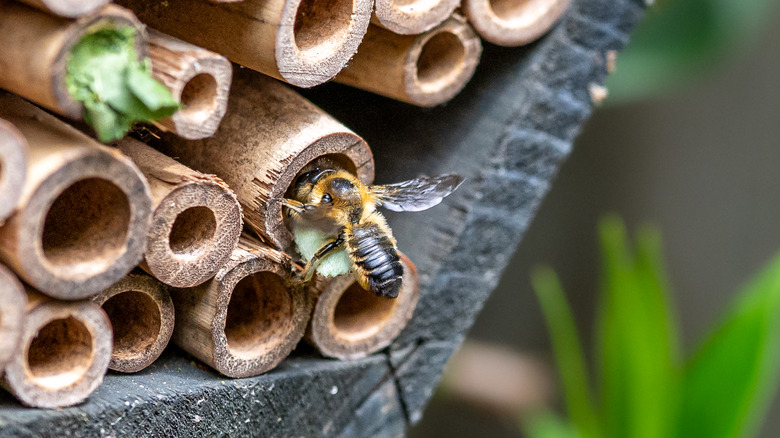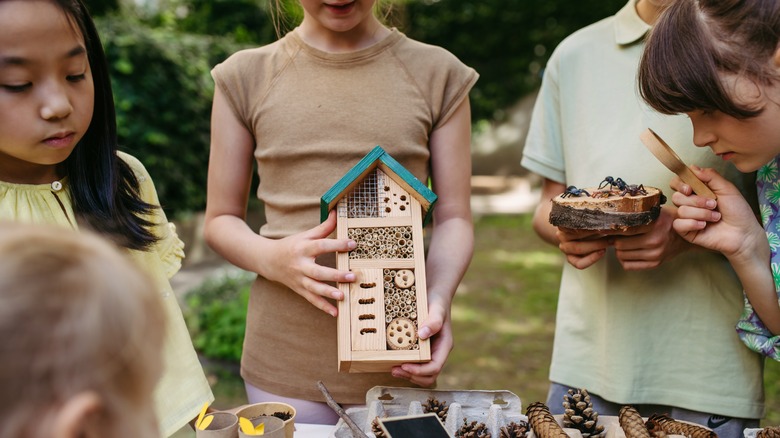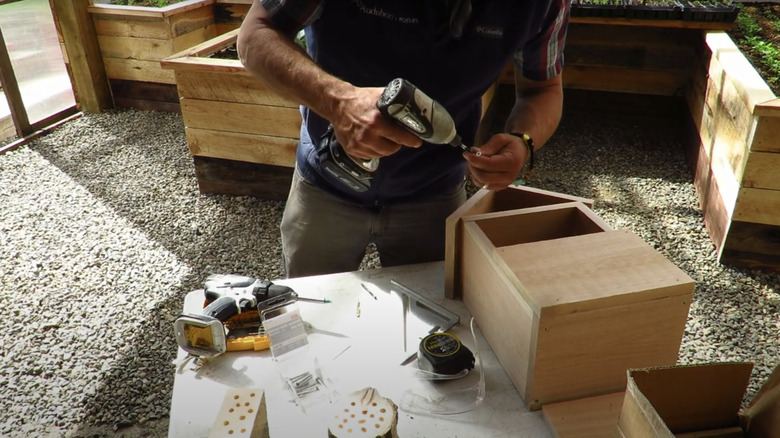How To Make A Pollinator-Friendly Bee Hotel For Your Garden
While creating a bee hotel in your yard might seem silly, it's actually essential for many solitary bees. Not all bees live in colonies in beehives. Some, much like people, are introverts who prefer solo lives and tend to live alone. There are many kinds of solitary bees and wasps, including the grass wasp or the mason bee.
In fact, the vast majority of all U.S. native bee species are solitary. That means most bees lack the luxuries of colonies or hives where they can spend the night or the winter. Normally, these solitary insects make their own homes out of hollow plant stems, in the space between stones, or even a hole they dig for themselves – placing them at the top of the list for flying insects that burrow in the ground.
We know pollinators are essential to any garden since the vast majority of plants rely on them. Solitary bees and wasps do their fair share of pollinating, and because they live alone, there's not much danger that they'll swarm people. In fact, solitary bees and wasps tend not to be territorial at all, and if someone gets too close to their nest, they're more likely to fly away than try to defend it. That's good news for anyone worried that putting up a bee hotel might attract aggressive, stinging insects. These quiet, hard-working introverts seem likely to remain shy even if you build them a new hotel or condo.
How a bee hotel can help solitary pollinators
With development in our suburbs and cities on the rise, there are fewer spots for solitary bees to call home, especially when we're in the habit of fall clean-ups. These clean-ups typically involve pruning back dead stems or foliage that they often nest in, making it harder to find a home close to food. Some bigger bees, like Carpenter bees, might be fine with flying farther to their home, but solitary bees are smaller and prefer a commute that's only a block or two from their favorite flowers. Many solo bees make several trips back home every day.
Also, solitary bees lay their eggs in these nests. So, the more time the mother bee spends away from the nest, the less time she's able to feed her young ones. There's the added threat that any time she's away, the eggs or larvae are at the mercy of predators. Bee hotels can help by providing shelter closer to the food. Planting lots of pollinator favorites, like creeping phlox, the gorgeous purple ground cover beloved by bees and butterflies alike, can help as well.
Bee hotels give us and our kids or grandkids the rare opportunity to see solitary bees up close. And since they're not likely to be aggressive, it's a great chance to see a nature documentary in real time. To make a bee hotel, all you need are a few simple items you can get at a craft store. Grab a weatherproof box, some bamboo reeds or cardboard straws, or just get a solid block of wood and your drill.
Make your own bee hotel in these easy steps
There are a couple of ways that you can approach this project. You can build your own bee house from scratch by nailing or screwing together pieces of wood into a house-like frame. Or, you can use a ready made weather-proof wooden box or shallow crate.
Either way, the concept is to provide hollow tubes in the wood, whether through reeds or drilled holes in solid blocks — the perfect accommodations for solitary bees. Each bee will make a reed or hollow bit their home with leaves or other insulating decorations, and then she'll begin laying eggs at the back of the tube. If you're wondering how the oldest larva manage to get out if they're the oldest eggs, fear not. Mama bees know what they're doing. They lay female eggs at the back, which take longer to develop, and male eggs in the front, which hatch first and leave home.
To make the perfect bee hotel, you can stack up your bamboo reeds or cardboard straws inside your box, one on top of the other with the hollow openings facing out of the box. If you're using a block of wood, or even a discarded tree stump, you can drill holes in this wood to act as your tunnels. Opt for different-sized holes or tubes, since solitary bees come in different sizes. And always make sure there's an overhang that keeps the entrances dry. Give your hotel a protective roof or place it in a sheltered spot away from the wind or rain. Hang it about chest-height, and you're good to go!


